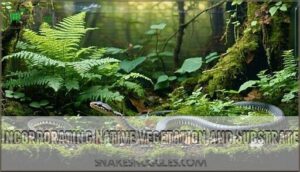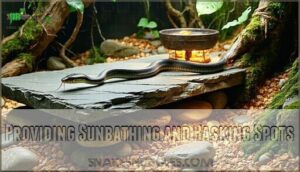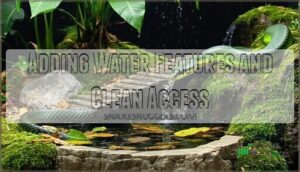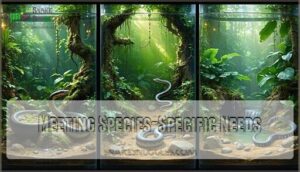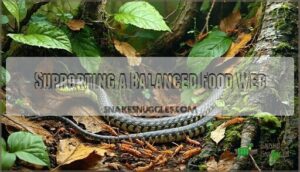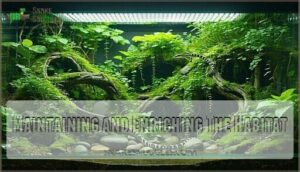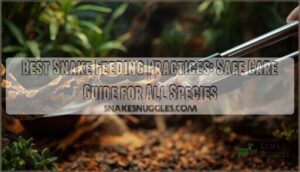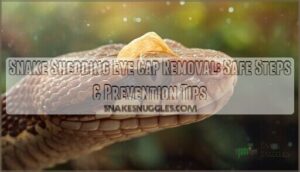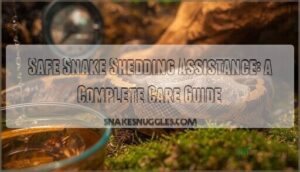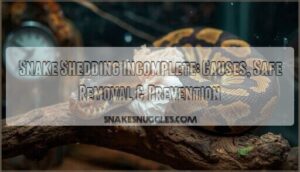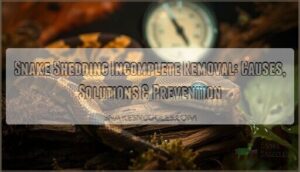This site is supported by our readers. We may earn a commission, at no cost to you, if you purchase through links.
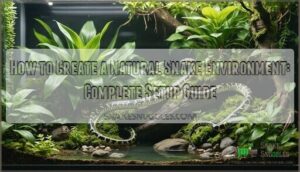 A wild snake doesn’t need an instruction manual to find shelter, regulate its body temperature, or hunt successfully—it relies on millions of years of evolutionary fine-tuning. Yet when we bring these reptiles into captivity, we’re basically asking them to thrive in a world we’ve designed, often with little understanding of what they actually need.
A wild snake doesn’t need an instruction manual to find shelter, regulate its body temperature, or hunt successfully—it relies on millions of years of evolutionary fine-tuning. Yet when we bring these reptiles into captivity, we’re basically asking them to thrive in a world we’ve designed, often with little understanding of what they actually need.
The difference between a sterile tank with a heat lamp and a thoughtfully constructed habitat isn’t just aesthetic—it directly impacts everything from stress levels and feeding response to immune function and longevity.
Creating a natural snake environment means moving beyond the bare minimum and instead replicating the intricate relationship of temperature zones, humidity pockets, hiding spots, and textures that wild snakes navigate instinctively. Get it right, and you’ll witness behaviors most keepers never see.
Table Of Contents
Key Takeaways
- A naturalistic snake habitat requires replicating thermal gradients, humidity zones, and hiding spots that mirror wild environments, as these directly impact stress levels, immune function, and longevity far beyond what a basic heat lamp and bare tank can provide.
- Proper enclosure design must account for adult snake dimensions from the start, incorporate species-specific needs like burrowing depth or climbing structures, and include multiple secure hides at different temperature zones to support natural thermoregulation and reduce stress.
- Maintaining habitat health demands regular sanitization with reptile-safe disinfectants, substrate replacement every 4-8 weeks, and environmental enrichment through rotating objects and textures to encourage natural behaviors like exploration and problem-solving.
- Supporting a balanced ecosystem within or around the habitat—through native vegetation, pesticide-free practices, and prey species sustainability—creates a self-maintaining environment that honors the snake’s evolutionary adaptations while contributing to broader wildlife conservation.
Choosing The Right Snake Enclosure
Your snake’s first home might be its forever home, so getting the enclosure right from the start saves you headaches down the road. The type of vivarium you choose—and what it’s made of—impacts everything from temperature control to your snake’s sense of security.
Let’s walk through the key factors that’ll help you pick an enclosure that works for both you and your scaled companion.
Selecting an Appropriate Vivarium
Choosing the right vivarium isn’t just about grabbing the first glass box you see—it’s the foundation that determines whether your snake thrives or merely survives. Start by researching your species’ natural history—enclosure size must accommodate adult length and activity patterns. A secure cover prevents escapes, while proper vivarium setup creates space for thermal gradients and natural behaviors.
Key vivarium selection priorities:
- Size matters from day one – Choose based on adult dimensions, not hatchling size
- Escape resistance is non-negotiable – Snakes are masters at finding weaknesses
- Species research drives every decision – Desert dwellers need different setups than rainforest species
- Growth potential affects long-term costs – Plan for your snake’s full size to avoid replacing enclosures
- Ventilation balances humidity and airflow – Stagnant air breeds respiratory problems
Material Considerations (Glass, Plastic, DIY)
Once you’ve settled on the right size and security features, the material of your enclosure shapes everything from heat retention to visibility—and each option comes with trade-offs worth understanding before you commit.
Glass offers durability and excellent viewing but carries weight concerns that complicate transport. Plastic enclosures provide safety and lighter portability, though they scratch easily. DIY naturalistic vivariums allow complete customization—just watch for substrate toxicity and sealing failures.
Your cost analysis should weigh initial investment against long-term maintenance needs.
Sizing for Growth and Activity
Your snake’s future size matters as much as its current dimensions—buy too small, and you’ll be shopping for a new home before the year’s out. Enclosure progression shouldn’t mean constant upgrades; instead, plan ahead by researching adult dimensions for your species. A juvenile corn snake thrives in smaller quarters initially, but anticipating its 4–6 foot adult length saves headaches.
Space requirements extend beyond mere body length—active hunters need room to patrol, while sedentary species prioritize vertical complexity over floor space.
- Growth monitoring informs habitat setup adjustments before your snake outgrows its environment
- Match enclosure design to behavioral needs: terrestrial species demand horizontal space, arboreals require height
- Activity levels vary dramatically—kingsnakes patrol constantly while ball pythons curl contentedly in tight quarters
- Adult dimensions should guide initial purchases; most species reach full size within 2–3 years
- A properly sized natural environment promotes thermoregulation, exercise, and psychological snake wellbeing
Escape Prevention and Safety
Even the most spacious, thoughtfully designed enclosure becomes worthless if your snake discovers a gap the width of its head and vanishes into your walls. Secure enclosures demand quality locking mechanisms—clips, sliding locks, or weighted lids that resist curious snouts. Vivarium security overlaps with childproofing concerns when households include kids or curious pets.
A worthless enclosure is one your snake can escape—secure every gap with quality locks because snakes exploit weaknesses you didn’t know existed
Emergency protocols matter—know your escape prevention weak points before testing them accidentally. Regular inspections of seals, hinges, and vents protect snake wellbeing by preventing traumatic disappearances that endanger both animal and household.
| Security Feature | Best For | Risk Addressed |
|---|---|---|
| Sliding locks | Glass terrariums | Lid displacement from pushing |
| Weighted lids | Screen-top enclosures | Upward pressure from climbing |
| Clip fasteners | Plastic tubs | Corner gaps and warping |
| Gasket seals | Custom builds | Ventilation holes exploited as exits |
Designing a Naturalistic Snake Habitat
Once you’ve selected the right enclosure, it’s time to bring your snake’s habitat to life. A naturalistic setup doesn’t just look better—it aids your snake’s instincts and overall well-being.
Here’s what you’ll need to think about as you design an environment that mimics the wild.
Incorporating Native Vegetation and Substrate
Think of native vegetation and substrate as the foundation of your snake’s world—the difference between a sterile box and a thriving ecosystem that mirrors the wild. Select native plant species that tolerate your snake habitat’s humidity level control needs while providing cover.
Layer substrate deep enough to support burrowing behavior—corn snakes won’t thrive without it. This naturalistic terrarium design approach transforms reptile substrate into functional microhabitat, not mere bedding.
Creating Hides, Rock Piles, and Logs
Shelter isn’t optional—it’s survival currency in the reptile world, and well-placed hides, rock piles, and logs deliver security that reduces stress and encourages natural behavior.
Position hide boxes at different thermal zones—snakes need hiding places whether they’re warming up or cooling down.
Stack rock piles with larger stones at the base for stability, creating crevices that mimic natural snake hiding place structures.
Incorporate logs horizontally and diagonally to offer varied cover and burrowing space beneath.
Providing Sunbathing and Basking Spots
Thermoregulation drives every aspect of a snake’s daily routine, so your basking spots need to deliver a thermally ideal zone where your resident reptile can soak up heat efficiently. Position overhead heat lamps to create a focused basking spot temperature gradient, allowing your snake to self-regulate effectively.
- Flat rocks absorb and radiate heat slowly, mimicking natural sunbathing spots
- Elevated branches provide secondary thermal regulation zones for arboreal activity
- Substrate heat sources supplement overhead warmth without replacing natural sunlight access
- UV light needs vary by species—research whether your snake requires supplemental lighting
- Temperature zones should range from cool to warm, giving your snake choices throughout the day
Adding Water Features and Clean Access
Water isn’t just a drinking resource—it’s a full-body thermoregulatory tool, a humidity regulator, and a prime hunting ground where your snake can shed its skin with ease.
Choose a water dish large enough for your snake to soak completely, with shallow access points to prevent drowning. Clean water sources every two to three days to prevent bacterial growth, and position your water feature where it naturally boosts humidity without saturating the substrate.
Meeting Species-Specific Needs
Not all snakes are the same, and your setup shouldn’t be either. What works for a corn snake won’t cut it for a ball python or a tree boa.
Let’s walk through the key considerations that’ll help you tailor the environment to your snake’s natural needs.
Researching Natural History and Behavior
Understanding your snake’s natural behaviors isn’t guesswork—it’s detective work rooted in Evolutionary Origins spanning 128 million years. Snakes are legless reptiles that belong to the suborder Serpentes. Researching animal natural history reveals how Habitat Adaptations, Snake Diets, Sensory Biology, and Defensive Behaviors shape daily life.
Before setting up your enclosure, investigate:
- Foraging patterns – nocturnal hunters versus daytime predators
- Sensory preferences – chemical cues, vibrational sensitivity, or visual hunting
- Defensive strategies – strike distance, camouflage tendencies, warning displays
- Activity zones – arboreal climbers, terrestrial wanderers, or aquatic specialists
Observing animal behavior in habitats helps you replicate what evolution perfected.
Establishing Thermal Gradients and Humidity
Your snake’s metabolism runs on temperature, not willpower—without the right thermal zones, even a well-fed serpent can’t digest a meal or fight off disease. Heating methods like ceramic emitters or under-tank pads create thermal gradients for reptiles, letting your snake shuttle between warm and cool zones.
Humidity control matters just as much—monitoring tools such as digital hygrometers track moisture levels essential for shedding and respiratory health.
| Species Variation | Temperature Range | Humidity Control |
|---|---|---|
| Ball Python | 78–92°F | 50–60% |
| Corn Snake | 75–85°F | 40–50% |
| Boa Constrictor | 80–90°F | 60–70% |
| King Snake | 75–85°F | 40–60% |
| Green Tree Python | 82–88°F | 70–80% |
Proper lighting requirements and temperature control aren’t luxuries—they’re survival tools that respect millions of years of adaptation.
Accommodating Burrowing and Climbing Behaviors
Once you’ve nailed the temperature and humidity, it’s time to honor what your snake actually does in the wild—whether that’s disappearing underground or scaling the nearest branch. Terrestrial species like corn snakes need deep substrate depth for naturalistic burrowing and tunnel stability, while arboreal pythons require sturdy branch placement and climbing enrichment.
Add rocks, a hide, and bark background to your terrarium—these features transform captivity into a space that respects instinct.
Preventing Inter-Species Conflicts
Even the most thoughtfully designed enclosure becomes a problem if you’re housing multiple snakes together—or worse, mixing species that view each other as threats or meals. Separate enclosures aren’t optional—they’re essential for animal welfare and prey safety.
Here’s what you need to monitor:
- Species compatibility: Different snakes have vastly different temperaments and stress triggers
- Size differences: Larger snakes may view smaller cage mates as food, regardless of species
- Behavioral observation: Watch for stress signals like refusal to eat or constant hiding
- Natural behaviors: Solitary species don’t benefit from companionship; enrichment comes from habitat design, not cohabitation
Your snake environment should respect its instincts, not force unnatural social dynamics.
Supporting a Balanced Food Web
A thriving snake habitat doesn’t stop at rocks and water—you need to think about what your snake eats, too. Creating conditions that support prey species means your environment becomes self-sustaining, mimicking what happens in the wild.
Let’s look at how you can build and maintain this critical foundation without disrupting the delicate balance.
Attracting and Sustaining Prey Species
Building a sustainable food supply means thinking like an ecosystem architect. Rodent populations, insect diversity, and amphibian habitats thrive when you plant native vegetation that bolsters the entire food web.
Bird attractants like seed-bearing plants also draw prey species that snakes naturally hunt. Encourage frogs, insects, and rodents by creating layered habitats—ground cover, water sources, and undisturbed areas where prey can reproduce safely.
Snakes also contribute to natural pest control, keeping slug populations in check. Sustainable feeding starts with patience, letting nature establish itself.
Avoiding Harmful Chemicals and Pesticides
Pesticides and synthetic chemicals work against you here, poisoning the very prey species your snake depends on while leaving toxic residues that can harm reptiles directly.
Opt for organic gardening practices that protect snake health and prevent water contamination.
A pesticide-free environment allows safe alternatives—like manual removal or companion planting—to manage pests without residue exposure, preserving the habitat your snake needs to thrive.
Maintaining a Healthy Garden Ecosystem
A thriving garden ecosystem doesn’t just happen—it’s built layer by layer, from the microbes in your soil to the predators patrolling your perimeter. Here’s how to strengthen yours:
- Plant native species that support local insects and biodiversity
- Compost regularly to boost soil health and microbial activity
- Conserve water with mulch and drip irrigation systems
- Encourage natural pest control through diverse plantings
This pesticide-free environment creates a self-sustaining snake habitat where organic gardening practices fuel wildlife conservation efforts.
Promoting Wildlife Conservation
Beyond building a snake habitat in your garden, you’re contributing to wildlife conservation on a larger scale. Habitat connectivity between your yard and neighboring green spaces strengthens population viability for local snake species.
Community involvement in anti-poaching efforts and habitat restoration maintains ecological balance, helping snakes control rodent populations naturally. Your garden ecosystem becomes part of a broader wildlife corridor:
| Conservation Action | Local Impact |
|---|---|
| Connecting habitats | Safer snake movement |
| Anti-poaching awareness | Protected populations |
| Community education | Reduced human-wildlife conflict |
Maintaining and Enriching The Habitat
Building a natural habitat is only the beginning—keeping it immaculate bolsters your snake’s health. Routine maintenance prevents disease, while thoughtful enrichment satisfies natural behaviors that captive environments can suppress.
Here’s how to maintain a thriving space that changes with your snake’s needs.
Regular Sanitization and Disease Prevention
Think of your snake’s home as a living system—one careless cleaning can introduce pathogens that spread faster than you’d expect, so sanitization isn’t just about keeping things tidy, it’s your first line of defense against disease.
Effective cleaning protocols protect snake health and animal wellbeing through consistent preventative measures:
- Use reptile-safe disinfectant choices that won’t leave harmful residues
- Implement quarantine procedures for new snakes to prevent cross-contamination
- Monitor environmental conditions during sanitizing animal habitats to maintain stability
- Practice parasite control through regular spot-cleaning and full enclosure sterilization
Proper snake care and maintenance means balancing thorough disinfection with minimal stress to your animal.
Substrate Refresh and Habitat Upkeep
Your snake’s substrate isn’t a "set it and forget it" feature—it’s a living layer that absorbs waste, harbors bacteria, and degrades over time, making regular refreshes non-negotiable for long-term health.
Effective substrate sanitation involves spot-cleaning daily and complete substrate replacement every 4–8 weeks depending on species and environmental conditions.
Monitor humidity balance during changes, rotate enrichment items to prevent bacterial buildup, and watch for pest control issues like mites in organic substrate materials—proactive snake care and maintenance prevents problems before they start.
Providing Environmental Enrichment
Enrichment transforms a functional enclosure into a lively space where snakes can express natural behaviors—exploring, hunting, and problem-solving—rather than simply existing in a static box.
Rotate branches, hides, and substrate textures monthly to provide cognitive challenges and sensory stimulation.
Scent trails, novel objects, and varied climbing opportunities encourage behavioral variety while addressing species-specific needs, keeping your snake mentally engaged and physically active.
Observing and Adjusting for Snake Well-Being
Watching your snake closely isn’t just about catching problems early—it’s how you learn to speak their language, reading subtle shifts in behavior that signal whether your habitat is hitting the mark or falling short.
Track behavioral cues like appetite changes, activity patterns, and body posture. Shedding issues or prolonged hiding often point to humidity problems, while health monitoring catches respiratory distress before it escalates.
Environmental tweaks—adjusting basking temps, adding hides, or reducing noise—drive stress reduction and support snake care proficiency.
Frequently Asked Questions (FAQs)
How often should I handle my snake safely?
Frequency of interaction hinges on your pet snake’s temperament and stress tolerance. Most reptiles thrive with brief, biweekly sessions using safe techniques.
Always practice proper hygiene practices to prevent disease transfer and monitor for stress signals during reptile care interactions.
Can multiple snake species coexist in one habitat?
Generally, no—housing multiple snake species together isn’t recommended due to Species Compatibility issues, Predation Risks, Dise Transmission, and Hybridization Concerns.
Different species compete for resources, disrupting habitat balance and threatening biodiversity in captive ecosystems.
How do I winterize outdoor snake habitats?
Most snakes naturally brumate during winter, but you can help by ensuring shelter like logs and rock piles remain intact.
Provide insulation methods such as leaf litter and maintain accessible water sources and food availability.
Protect the habitat from predators to further support their survival.
What signs indicate my snake is stressed?
Like a Victorian naturalist observing specimen behavior, watch for hiding excessively, refusing food, erratic movements, shedding problems, and defensive behavior—clear signs your snake needs better environmental conditions, proper enclosure setup, or adjustments in reptile husbandry and snake care and wellbeing.
Conclusion
A snake doesn’t simply occupy its habitat—it becomes an extension of it, moving through microclimates and textures like water finding its path. Creating a natural snake environment isn’t about checking boxes; it’s about understanding that every crevice, humidity gradient, and hiding spot speaks directly to your snake’s physiology.
When you replicate what evolution designed, you’re not just building an enclosure—you’re honoring the blueprint that’s kept these animals thriving for millennia. The reward? A snake that behaves, feeds, and lives as nature intended.

